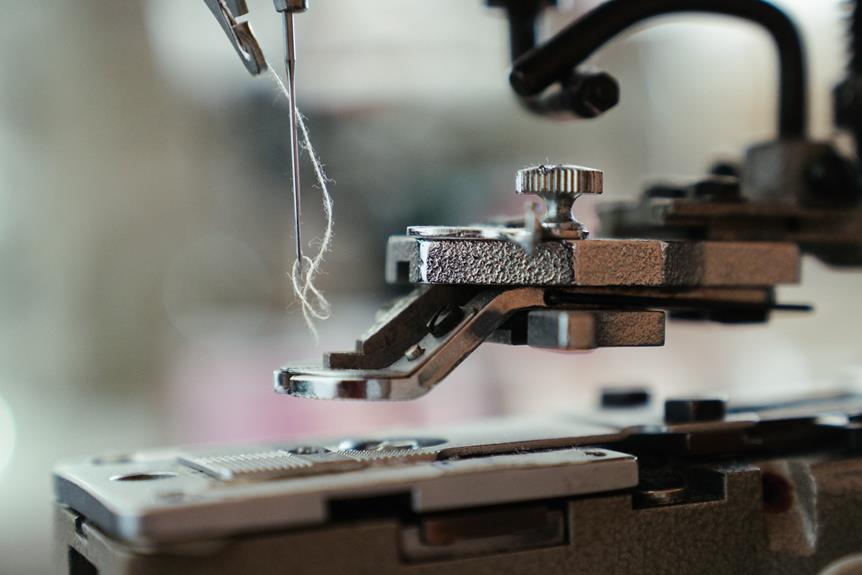Do you feel like sewing machine needle numbers are an unsolvable mystery? Fear not! Understanding sewing machine needle numbers is crucial for mastering the art of sewing. By deciphering the numbers on the needle packages, you can confidently select the right needle for your fabric and project.
This knowledge will elevate your sewing game and ensure smooth, professional-looking stitches every time. So, let's dive into the world of sewing machine needle numbers and unravel the secrets they hold.
Key Takeaways
- The anatomy of a sewing machine needle includes the shank, shaft, groove, scarf, and eye, all of which play a role in stitch quality and compatibility with sewing machines.
- Understanding needle size and type is crucial, as different fabrics and threads require specific needle types and sizes.
- Needle construction determines its purpose, with ballpoint tips for knit fabrics and sharp points for woven fabrics.
- When selecting a needle, consider the material options (chrome-plated, titanium, or gold-plated), compatibility with different fabrics, and specialized needle types for specific projects. Regular needle maintenance is also important for preventing stitching problems and fabric damage.
The Anatomy of Sewing Machine Needle Numbers
To understand the anatomy of sewing machine needle numbers, you need to know the specific parts and their corresponding numerical designations. Needle construction is a crucial aspect to comprehend. The shank, which is the upper part of the needle, plays a vital role in needle compatibility. It's important to note that different sewing machines require specific shank types. The needle's shaft, located below the shank, varies in diameter depending on the needle size. Understanding these components is essential for selecting the right needle for your sewing project.
Additionally, needle compatibility is determined by the groove, scarf, eye, and point. The groove allows the thread to pass smoothly through the needle during the stitching process. The scarf, located on the back of the needle, helps to prevent skipped stitches. The eye is where the thread passes through, and its size and shape influence the stitch quality. The point of the needle varies based on the type of fabric being used.
Deciphering Needle Size and Type
Understanding sewing machine needle numbers involves deciphering the size and type of needle appropriate for your specific sewing project, ensuring compatibility and optimal stitching results. When selecting a needle, consider the fabric type and thickness to ensure the right needle size and type for the job.
Here are some key factors to consider when deciphering needle size and type:
- Needle Material Variations: Different needle materials, such as chrome-plated, titanium, or gold-plated, offer varying degrees of durability and can be suitable for different types of fabrics. Understanding the properties of these materials can help you select the most appropriate needle for your project.
- Needle Size Conversion Chart: Familiarize yourself with the needle size conversion chart to understand the differences between sizing systems, such as American and European. This knowledge will help you accurately select the right needle size for your sewing machine.
- Fabric Type Compatibility: Different fabrics, such as denim, silk, or leather, require specific needle types and sizes to ensure optimal stitching results. Understanding the compatibility between needle types and fabric materials is essential for achieving professional-looking results.
- Thread Compatibility: Consider the type and weight of the thread you plan to use, as this can also influence the selection of the appropriate needle size and type for your sewing project.
Understanding Needle Purpose and Function
Explore the specific roles and functions of sewing machine needles to gain insight into their critical impact on stitch quality and fabric handling.
Needle construction plays a vital role in determining the needle's purpose. For instance, needles designed for knit fabrics have a ballpoint tip to prevent snags and runs, while those intended for woven fabrics feature a sharp point for piercing through the fibers.
Understanding needle compatibility is essential for achieving optimal sewing results. Using the wrong needle for a specific fabric can lead to skipped stitches, thread breakage, or damage to the fabric. It's crucial to match the needle size and type to the fabric weight and type.
For instance, lightweight fabrics require a smaller needle size to prevent visible holes, while heavyweight fabrics need a larger needle to penetrate the thicker layers.
Selecting the Right Needle for Your Project
Selecting the right needle for your project depends on the fabric type and weight, ensuring optimal stitch quality and fabric handling. When choosing a needle for your sewing project, consider the following factors:
- Needle material options: Different needle materials, such as chrome-plated, titanium, or gold-plated, offer varying degrees of strength and durability. Chrome-plated needles are suitable for general sewing, while titanium needles are ideal for heavy-duty fabrics, and gold-plated needles are excellent for embroidery work.
- Needle compatibility with different fabrics: Match the needle size and type to the fabric you're using. For instance, use a ballpoint needle for knit fabrics to prevent snags or skipped stitches, and a sharp needle for woven fabrics to create crisp, clean stitches. Additionally, consider the needle size; thicker fabrics require larger needles, while delicate fabrics need finer needles.
- Specialized needle types: Explore specialized needle options such as denim needles for heavyweight fabrics, quilting needles for multiple layers, or embroidery needles for decorative stitching. These specialized needles are designed to tackle specific fabric and project requirements, ensuring precise and professional results.
- Regular needle maintenance: Remember to change your needle regularly, as dull or bent needles can cause stitching problems and damage your fabric. A good practice is to change the needle after every 8 hours of sewing or after completing a significant project.
Tips for Maintaining and Using Needles
To ensure optimal performance and longevity of your sewing machine needles, it's essential to implement proper maintenance practices and utilize them correctly for different fabric types.
When using your sewing machine, always start with a new needle to prevent any potential issues. After eight hours of sewing, replace the needle to ensure it remains sharp and reduces the risk of breaking.
Carefully troubleshoot any stitching issues, as they can often be a sign of a dull or damaged needle.
Proper storage is also crucial for needle longevity. Store them in their original packaging or a labeled case to prevent damage and keep track of their type and size.
When using needles, match the size to the fabric type; for example, use a finer needle for lightweight fabrics and a larger needle for heavy fabrics.
Frequently Asked Questions
Can Sewing Machine Needles Be Used for Both Hand Sewing and Machine Sewing?
Yes, sewing machine needles are specifically designed for machine sewing, while hand sewing needles are meant for hand sewing. Each type has different sizes and shapes to suit their specific functions and requirements.
How Do I Know if a Needle Is Dull and Needs to Be Replaced?
When your needle is dull, you'll notice skipped stitches, fabric pulls, or frayed threads. These are signs it needs replacing. Different types of sewing, like quilting or embroidery, require specific needle types for best results.
What Are the Differences Between Universal Needles and Specialty Needles?
When choosing between universal and specialty needles, consider needle compatibility for your sewing projects. Specialized needles vary in material and are designed for specific sewing techniques. Make sure to match the needle to your project's requirements.
Are There Any Tips for Preventing Needles From Breaking During Sewing?
To prevent needle breakage during sewing, it's crucial to use the right needle for your fabric, change needles regularly, and ensure proper maintenance of your sewing machine. This will help avoid frustrating and time-consuming interruptions.
Can I Use Different Needle Sizes on the Same Project for Different Fabric Types?
Yes, you can use different needle sizes on the same project for different fabric types. It's important to match the needle compatibility with the fabric type to ensure project versatility and optimal results.
- How Does Ring Spun Cotton Affect Garment Fit and Shape Retention? - August 13, 2024
- What Are the Challenges in Producing Ring Spun Cotton? - August 13, 2024
- Is Ring Spun Cotton Suitable for Plus-Size Clothing? - August 13, 2024






